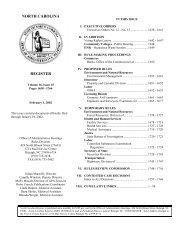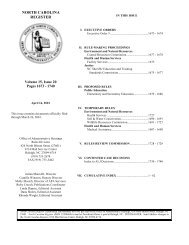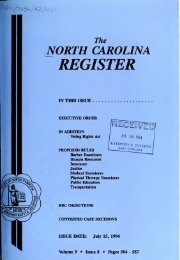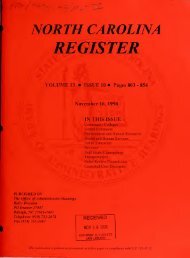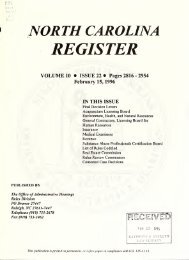NC Register Volume 21 Issue 09 - Office of Administrative Hearings
NC Register Volume 21 Issue 09 - Office of Administrative Hearings
NC Register Volume 21 Issue 09 - Office of Administrative Hearings
Create successful ePaper yourself
Turn your PDF publications into a flip-book with our unique Google optimized e-Paper software.
CONTESTED CASE DECISIONS<br />
23. The Clean Water Act further requires that state agencies issuing NPDES permits follow certain notice and comment<br />
procedures in developing new permits. “[P]ublic participation in the development, revision, and enforcement <strong>of</strong> any regulation,<br />
standard, effluent limitation, plan or program established by . . . any State under this Act shall be provided for, encouraged, and<br />
assisted by . . . the States.” 33 U.S.C. §1251(e) (2006).<br />
24. The Second Circuit Court <strong>of</strong> Appeals recently invalidated federal regulations governing NPDES permitting for<br />
confined animal operations that did not require nutrient management plans to be included in the permit and noticed to the public.<br />
Waterkeeper Alliance, Inc., et. al. v. EPA, 2005 U.S. App. LEXIS 6533, 6540 (2nd Cir. 2005). “Since nutrient management plans<br />
embody all the relevant ‘site specific management practices,’ it is clear that…nutrient management plans are a sine qua non <strong>of</strong> the<br />
‘regulation, standard, plan, or program’” under 33 U.S.C. § 1251(e) (2006). The Court held that because the management plans<br />
contained non-numerical effluent limitations in the form <strong>of</strong> best management practices, the rule “by failing to require that the terms <strong>of</strong><br />
the nutrient management plans be included in NPDES permits—violates the Clean Water Act and is otherwise arbitrary and capricious<br />
in violation <strong>of</strong> the <strong>Administrative</strong> Procedure Act.”<br />
25. In the stormwater permitting context, stormwater management plans are equivalent to nutrient management plans.<br />
The stormwater management plans are supposed to contain “all relevant ‘site specific management measures’” that will be<br />
implemented in the Goose Creek watershed to reduce the discharge <strong>of</strong> stormwater pollution. Waterkeeper Alliance, Inc, 2005 U.S.<br />
App. LEXIS at 43. Therefore, Respondent violated 33 U.S.C. §§ 1311(a)-(b) and 1342(a) by not including the plans in the NPDES<br />
Phase II stormwater permits.<br />
26. As a necessary part <strong>of</strong> the NPDES permits, the stormwater management plans should also have been subject to the<br />
public participation requirement under 33 U.S.C. § 1251(e) (2006). Pursuant to 33 U.S.C. § 1342(j) (2006), “a copy <strong>of</strong> each permit<br />
application and each permit issued under this section shall be available to the public.” Since the three challenged NPDES Phase II<br />
permits were noticed without including the stormwater management plans, Respondent violated 33 U.S.C. §§ 1251(e), 1311, 1342(a)<br />
(2006). Further, Respondent violated 33 U.S.C. § 1342(j) (2006) by failing to provide copies <strong>of</strong> the stormwater management plans to<br />
members <strong>of</strong> the public who requested copies <strong>of</strong> the draft permit.<br />
27. Because Respondent violated the requirements <strong>of</strong> the federal Clean Water Act and the federal regulations<br />
implementing the Phase II program, Respondent exceeded its statutory authority, failed to use proper procedure, acted contrary to law,<br />
and acted arbitrarily and capriciously. N.C. Gen. Stat. § 150B-23(a)(1)-(5) (2006).<br />
Contested <strong>Issue</strong> No. 3:<br />
28. NPDES permits must contain “any more stringent limitation . . . necessary to meet water quality standards.” 33<br />
U.S.C. § 1311(b)(1)(C) (2006). Pursuant to this requirement, NPDES permits for discharges to waters for which a TMDL has been<br />
established must be consistent with the waste load allocation in the TMDL. 40 C.F.R. §§ 122.44(d)(a)(vii)(B); 130.12(a) (2006).<br />
29. As discussed more fully in the Findings <strong>of</strong> Fact 72-79, Goose Creek is subject to a final TMDL for fecal coliform<br />
discharges. The waste load allocation in the Goose Creek TMDL calls for a ninety-two point five percent (92.5%) reduction in current<br />
fecal coliform discharges.<br />
30. The challenged permits do not contain limits and conditions that will reduce current discharges. The permits as<br />
written will in fact increase fecal coliform discharges.<br />
31. By not including limits and conditions that will reduce current discharges <strong>of</strong> fecal coliform, Respondent has violated<br />
33 U.S.C. § 1311(b)(1)(C) and 40 C.F.R. §§ 122.44 (d)(a)(vii)(B) and 130.12(a).<br />
32. Because Respondent violated the requirements <strong>of</strong> the federal Clean Water Act, Respondent also exceeded its statutory<br />
authority, failed to use proper procedure, acted contrary to law, and acted arbitrarily and capriciously. N.C. Gen. Stat. § 150B-<br />
23(a)(1)-(5) (2006).<br />
BASED UPON the foregoing Stipulations, Findings <strong>of</strong> Fact and Conclusions <strong>of</strong> Law, the undersigned renders the following:<br />
DECISION<br />
That Respondent must reopen, amend, and reissue the NPDES permits to incorporate the USFWS’s determinations <strong>of</strong><br />
measures necessary to protect the habitat for the Carolina heelsplitter. Those measures are two-hundred foot buffers for perennial<br />
streams, one-hundred foot buffers for intermittent streams, a zero percent impervious surface threshold for structural stormwater<br />
<strong>21</strong>:<strong>09</strong> NORTH CAROLINA REGISTER NOVEMBER 1, 2006<br />
876




